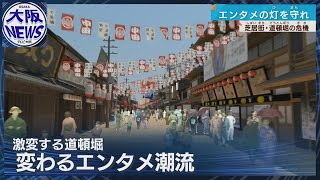
While Dotonbori has long flourished as a theater town since the Taisho era, recent years have seen one closure after another. At the same time, new initiatives are emerging to carry forward the tradition, from privately funded theaters to digital recreations and new performance venues, as the community looks at both the history and future of the neighborhood.
The news broke on August 28th that Shochiku Co. would shutter the Osaka Shochikuza Theater in spring 2026. The theater, rebuilt in 1997 as a second-generation facility to address deterioration, still retains its original grand entrance from 1923, known locally as the “Dotonbori Arc de Triomphe.” Once opened as Japan’s first reinforced-concrete cinema, it has since hosted a wide range of productions, from new plays and kabuki to idol group concerts, with around 20 performances annually.
The closure comes as Dotonbori’s largest stage prepares to go dark, following a wave of theater shutdowns amid rising land costs and redevelopment pressures driven in part by inbound tourism. Yet even in these difficult times, new projects are taking shape. In 2019, the Namikiza Theater and Museum opened as both a performance space and a cultural archive. Manager Yamane, who invested about 200 million yen of his personal fortune to acquire the land and building, explained: “People call me foolish, but I felt I had to do this. Whether the 400 years of theater culture in Dotonbori survive or not depends on our generation.” The venue draws significant foreign visitors, and Yamane works to explain traditional performing arts in English.
Dotonbori’s theatrical history stretches back nearly 400 years, when five large theaters—Naniwaza, Nakaza, Kadoza, Asahiza, and Bentenza—made the district Japan’s version of Broadway. Many stage conventions such as trapdoors and revolving platforms, now seen worldwide, originated here.
Local rakugo storyteller Tsukimoto Fumon, who grew up nearby and now holds regular performances in Dotonbori, said: “For us, this district was our playground. It’s not just about tourism; it’s about keeping alive the places filled with our memories. As these old venues disappear, we risk losing the soul of Osaka’s entertainment culture.”
Another approach is underway at Kansai University, where Professor Hayashi leads a project using computer graphics to digitally reconstruct Dotonbori’s theater district. “For younger generations who have never seen it, CG can help them experience how the district once looked and spark new interest in the performing arts,” Hayashi said.
In March this year, a new entertainment facility, Giraffe Japan, opened on the former site of Nakaza Theater. Operated by JTB, it offers nightly shows of music, impersonations of world-famous artists, and performances designed to transcend language barriers. Sugawara of JTB explained: “It’s a new type of entertainment rarely seen in Japan, but one that connects back to Dotonbori’s roots as a hub of theatrical culture.”
Source: Television OSAKA NEWS



